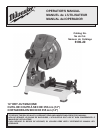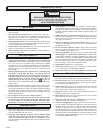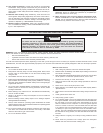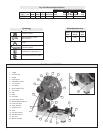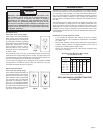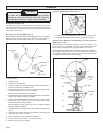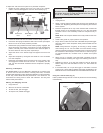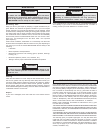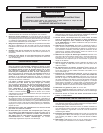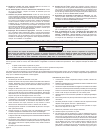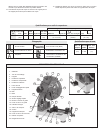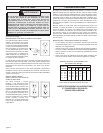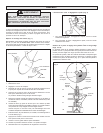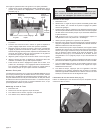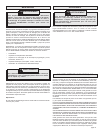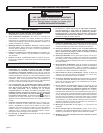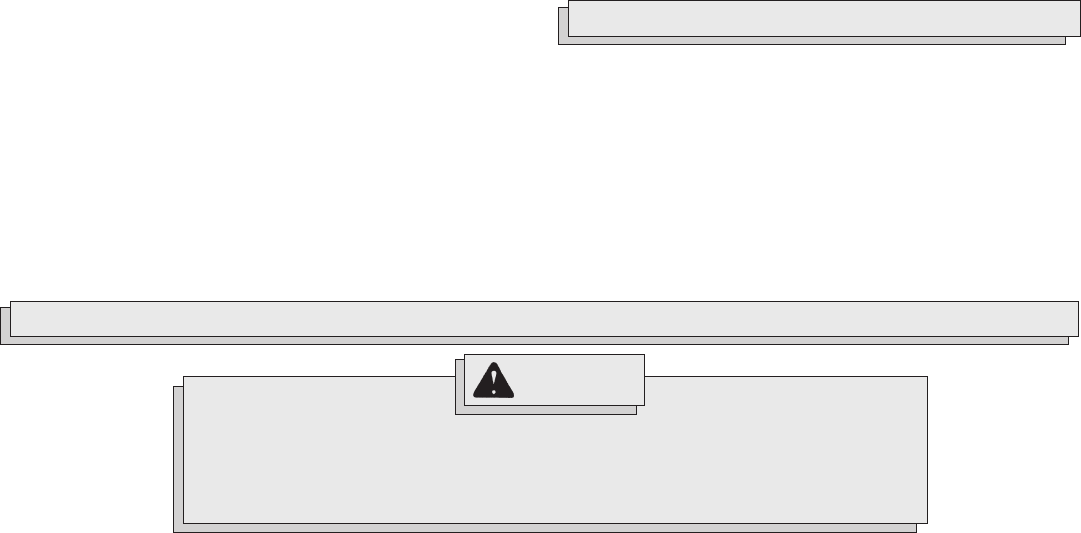
page 3
Machine Instructions
1. Start cutting only after the motor has reached full speed.
2. Release switch immediately if the blade stops rotating or if the motor
sounds like it is straining.
3. Keep flammable and fragile objects away from this tool. Do not allow
cut-off sparks to contact the operator's hands, face or feet.
4. Place the tool securely on a flat, level surface.
5. Always use the tool with the proper voltage specified on the tool's
nameplate.
6. Never touch a short cut-off piece until it cools.
7. Never attempt to cut material larger than the rated capacity listed in
“Specifications”.
8. Never stand in line with the blade while cutting. Always stand to the
side.
9. Check guards before each use.
10. Always keep guards in place.
11. Do not defeat guards. The tool is shipped with both the upper and
lower guard installed. The lower guard should cover the blade when
the saw head is up and it should open automatically as the saw
head is lowered into the workpiece. If the lower guard appears
loose or if it does not move to cover the blade when the saw head
is up, take the saw to an authorized service center for repairs. Do
not attempt to open the guard further than the automatic action
permits. The tool is designed so that when the guard is opened with
the saw head in the up position, the saw head will not be able to be
lowered.
12. Always start the cut gently. Do not bump or bang a blade to start a
cut.
13. Never make any freehand cuts. Always place the workpiece
between the vise and fence when making cuts.
SPECIFIC SAFETY INSTRUCTIONS - DRY-CUT MACHINE
Blade Instructions
1. Do not allow the blade to twist or bind.
2. Keep hands and body away from the rotating blade. Never reach
around, under or across blade. Do not wear loose clothing when
using this tool.
3. Store blades with care. Do not drop them.
4. Make sure that all blade flanges and other mounting hardware are in
good condition and are always used properly. Defective or missing
parts may cause damage to the blade. Always use mounting flanges
supplied with the tool.
5. Do not use dull or damaged blades. Unsharpened or improperly set
blades produce a narrow kerf causing excessive friction, blade
binding and kickback.
6. Before starting a cut, make a trial run. The blade should rotate freely
and not contact the table.
7. Never try to remove or clamp the workpiece to the tool while the
blade is rotating.
8. Before installing a blade, always inspect it for damage. Replace
damaged blades immediately.
9. Always check maximum operating speed established for blade
against machine speed. Do not exceed the maximum operating speed
that is marked on the blade.
10. Do not force a blade onto the machine or alter the size of the arbor
hole. Don't use a blade that fits the arbor too loosely. If the blade
doesn't fit the machine, get one that does.
11. Do not use abrasive wheels.
SERVICE
31. Tool service must be performed only by qualified repair
personnel. Service or maintenance performed by unqualified per-
sonnel may result in a risk of injury.
32. When servicing a tool, use only identical replacement parts.
follow instructions in the maintenance section of this
manual. Use of unauthorized parts or failure to follow maintenance
instructions may create a risk of shock or injury.
28. Use proper accessories. Consult this manual for recommended
accessories. Using improper accessories may be hazardous. Be
sure accessories are properly installed and maintained. Do not de-
feat a guard or other safety device when installing an accessory or
attachment.
29. Maintain tools carefully. Keep handles dry, clean and free from
oil and grease. Keep cutting edges sharp and clean. Follow instruc-
tions for lubricating and changing accessories. Periodically inspect
tool cords and extension cords for damage. Have damaged parts
repaired or replaced by a MILWAUKEE service facility.
30. Maintain labels & nameplates. These carry important informa-
tion. If unreadable or missing, contact a MILWAUKEE service facil-
ity for a free replacement.
WARNING! Some dust created by power sanding, sawing, grinding, drilling, and other construction activities contains chemicals known to cause
cancer, birth defects or other reproductive harm. Some examples of these chemicals are:
• lead from lead-based paint
• crystalline silica from bricks and cement and other masonry products, and
• arsenic and chromium from chemically-treated lumber.
Your risk from these exposures varies, depending on how often you do this type of work. To reduce your exposure to these chemicals: work in a well
ventilated area, and work with approved safety equipment, such as those dust masks that are specially designed to filter out microscopic particles.
WARNING!
To reduce the risk of injury, avoid inhalation of dust generated by grinding and cutting
operations. Exposure to dust may cause respiratory ailments. Use approved NIOSH or
OSHA respirators, safety glasses or face shields, gloves and protective clothing. Provide
adequate ventilation to eliminate dust, or to maintain dust level below the Threshold
Limit Value for nuisance dust as classified by OSHA.



